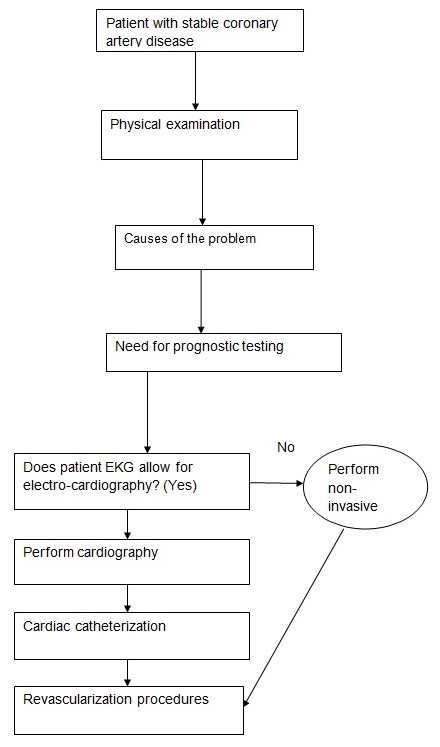Introduction
Coronary artery disease affects the heart. The aorta is the main supplier of blood in the body. It branches into two main blood vessels. Coronary artery disease affects the arteries whereby plaque or fats are deposited on its walls. Plaque on the walls of the arteries restricts the flow of blood (Taubenberger & Morens, 2006). The disease can lead to death, however, it is manageable. An algorithm on coronary artery disease can help in stabilizing the disease.
Indicators of the Algorithm
The algorithm for a patient with stable artery disease will have different indicators. One of the indicators is a physical examination of the patient. The examination will show the causes of the disease. Prognostic testing will also be an element in the algorithm. The prognostic test will help in identifying how well the patient can be fair in the treatment program. Electro cardiology will also be an indicator (Taubenberger & Morens, 2006). It is the process of recording the electric activity in the heart over some time. The process will help in analyzing the performance of the heart. Cardiac catheterization is another indicator in the algorithm.
Logical Process of the Algorithm

As shown in the diagram above, the algorithm provides the formula to be used when treating coronary artery disease. A patient with stable coronary artery disease has to undergo a medical examination. The examination will show the causes of the problem and the need for prognostic testing (Ryan, 1989). The patient will also have to undergo a cardiography that is if the EKG allows. If the EKG does not allow, then the patient has to undergo a non-invasive procedure. Cardiography will be undertaken if EKG allows. Cardiac catheterization will follow and finally revascularization procedure.
Salient feature
Treatment of the problem is the major salient feature in this algorithm. Treatment of coronary artery disease can take different forms (Ryan, 1989). The different forms depending on the age and the condition of the problem. The algorithm above applies to people with stable conditions.
Strengths and Limitations of the Algorithm
The strengths of this algorithm include accuracy in terms of dealing with coronary artery disease. It also improves the outcomes of the patient as well as reduces the overall cost of treatment (Kulldorff, 2001). Radiation used in this procedure has a lower burden. The only limitation in this algorithm is the overreliance on computed tomography coronary angiography. The quality of the image produced is low (Lombardo & Buckeridge, 2007).
Conclusion
An algorithm for coronary artery disease is important in different ways. It can work in the best way to prevent the loss of life of people affected by heart disease. Having the formula to follow is very important in managing and treating complex health problems.
References
Kulldorff, M. (2001). Prospective time periodic geographical disease surveillance using a scan statistic. Journal of the Royal Statistical Society, 164(1), 61-72.
Lombardo, J., & Buckeridge, D. (2007). Disease surveillance: A public health informatics approach. Hoboken, NJ: Wiley-Interscience.
Ryan, T. (1989). Statistical methods for quality improvement. New York: Wiley & Sons.
Taubenberger, J., & Morens, D. (2006). 1918 influenza: The mother of all pandemics. Emerging Infectious Diseases, 12(1), 15-22.